Child Development: Formative Assessment Activities Explained
VerifiedAdded on 2019/09/22
|17
|7658
|467
Homework Assignment
AI Summary
This document provides comprehensive solutions to a child development assignment, addressing various aspects of early childhood education. It begins by explaining the importance of routine for children, including its impact on confidence, independence, and self-control. The assignment then explores factors educators should consider when establishing routines and suggests activities promoting physical, cognitive, and social development. The document further discusses the significance of accessible materials for hands-on learning, providing examples of play materials for different age groups. It also delves into the concept of wellbeing, outlining its dimensions and offering strategies for educating children about physical and mental health. The assignment also examines skills that help children control their behavior, the development of morality, and methods for teaching responsibility. Finally, it highlights the benefits of one-to-one interactions and techniques to foster them, offering practical advice for educators. The assignment is a valuable resource for students studying child development and early childhood education, offering insights into key concepts and practical applications.
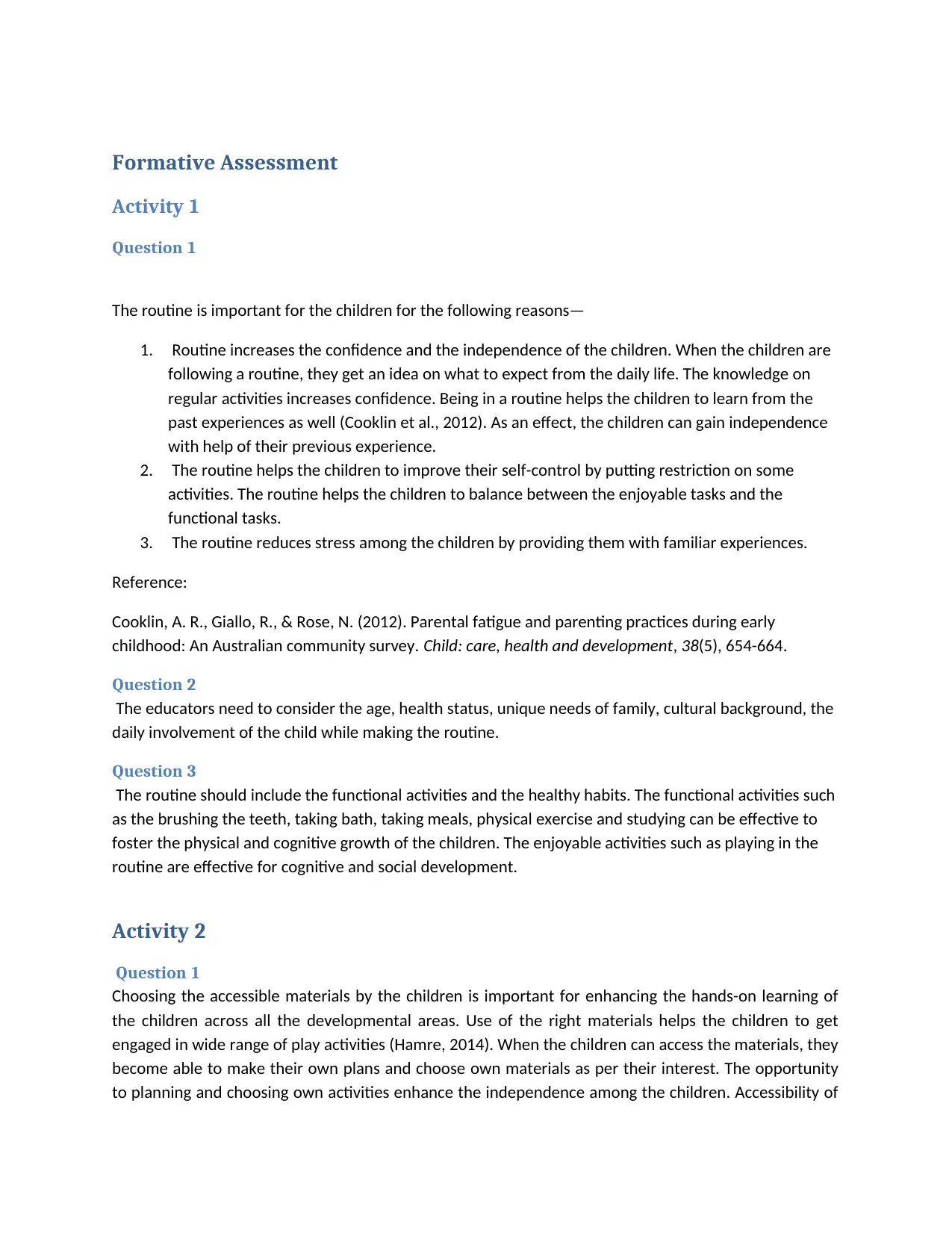
Formative Assessment
Activity 1
Question 1
The routine is important for the children for the following reasons—
1. Routine increases the confidence and the independence of the children. When the children are
following a routine, they get an idea on what to expect from the daily life. The knowledge on
regular activities increases confidence. Being in a routine helps the children to learn from the
past experiences as well (Cooklin et al., 2012). As an effect, the children can gain independence
with help of their previous experience.
2. The routine helps the children to improve their self-control by putting restriction on some
activities. The routine helps the children to balance between the enjoyable tasks and the
functional tasks.
3. The routine reduces stress among the children by providing them with familiar experiences.
Reference:
Cooklin, A. R., Giallo, R., & Rose, N. (2012). Parental fatigue and parenting practices during early
childhood: An Australian community survey. Child: care, health and development, 38(5), 654-664.
Question 2
The educators need to consider the age, health status, unique needs of family, cultural background, the
daily involvement of the child while making the routine.
Question 3
The routine should include the functional activities and the healthy habits. The functional activities such
as the brushing the teeth, taking bath, taking meals, physical exercise and studying can be effective to
foster the physical and cognitive growth of the children. The enjoyable activities such as playing in the
routine are effective for cognitive and social development.
Activity 2
Question 1
Choosing the accessible materials by the children is important for enhancing the hands-on learning of
the children across all the developmental areas. Use of the right materials helps the children to get
engaged in wide range of play activities (Hamre, 2014). When the children can access the materials, they
become able to make their own plans and choose own materials as per their interest. The opportunity
to planning and choosing own activities enhance the independence among the children. Accessibility of
Activity 1
Question 1
The routine is important for the children for the following reasons—
1. Routine increases the confidence and the independence of the children. When the children are
following a routine, they get an idea on what to expect from the daily life. The knowledge on
regular activities increases confidence. Being in a routine helps the children to learn from the
past experiences as well (Cooklin et al., 2012). As an effect, the children can gain independence
with help of their previous experience.
2. The routine helps the children to improve their self-control by putting restriction on some
activities. The routine helps the children to balance between the enjoyable tasks and the
functional tasks.
3. The routine reduces stress among the children by providing them with familiar experiences.
Reference:
Cooklin, A. R., Giallo, R., & Rose, N. (2012). Parental fatigue and parenting practices during early
childhood: An Australian community survey. Child: care, health and development, 38(5), 654-664.
Question 2
The educators need to consider the age, health status, unique needs of family, cultural background, the
daily involvement of the child while making the routine.
Question 3
The routine should include the functional activities and the healthy habits. The functional activities such
as the brushing the teeth, taking bath, taking meals, physical exercise and studying can be effective to
foster the physical and cognitive growth of the children. The enjoyable activities such as playing in the
routine are effective for cognitive and social development.
Activity 2
Question 1
Choosing the accessible materials by the children is important for enhancing the hands-on learning of
the children across all the developmental areas. Use of the right materials helps the children to get
engaged in wide range of play activities (Hamre, 2014). When the children can access the materials, they
become able to make their own plans and choose own materials as per their interest. The opportunity
to planning and choosing own activities enhance the independence among the children. Accessibility of
Paraphrase This Document
Need a fresh take? Get an instant paraphrase of this document with our AI Paraphraser
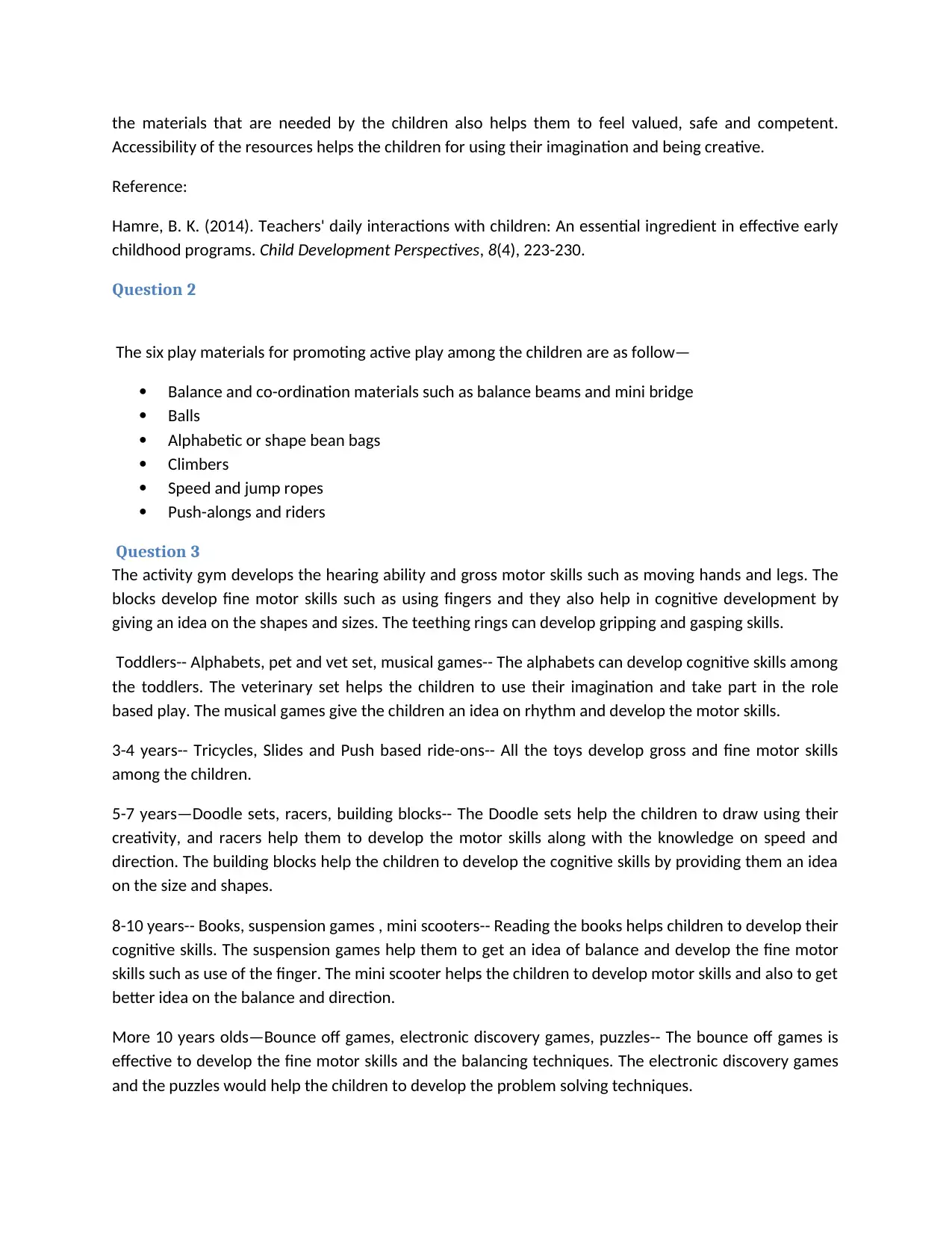
the materials that are needed by the children also helps them to feel valued, safe and competent.
Accessibility of the resources helps the children for using their imagination and being creative.
Reference:
Hamre, B. K. (2014). Teachers' daily interactions with children: An essential ingredient in effective early
childhood programs. Child Development Perspectives, 8(4), 223-230.
Question 2
The six play materials for promoting active play among the children are as follow—
Balance and co-ordination materials such as balance beams and mini bridge
Balls
Alphabetic or shape bean bags
Climbers
Speed and jump ropes
Push-alongs and riders
Question 3
The activity gym develops the hearing ability and gross motor skills such as moving hands and legs. The
blocks develop fine motor skills such as using fingers and they also help in cognitive development by
giving an idea on the shapes and sizes. The teething rings can develop gripping and gasping skills.
Toddlers-- Alphabets, pet and vet set, musical games-- The alphabets can develop cognitive skills among
the toddlers. The veterinary set helps the children to use their imagination and take part in the role
based play. The musical games give the children an idea on rhythm and develop the motor skills.
3-4 years-- Tricycles, Slides and Push based ride-ons-- All the toys develop gross and fine motor skills
among the children.
5-7 years—Doodle sets, racers, building blocks-- The Doodle sets help the children to draw using their
creativity, and racers help them to develop the motor skills along with the knowledge on speed and
direction. The building blocks help the children to develop the cognitive skills by providing them an idea
on the size and shapes.
8-10 years-- Books, suspension games , mini scooters-- Reading the books helps children to develop their
cognitive skills. The suspension games help them to get an idea of balance and develop the fine motor
skills such as use of the finger. The mini scooter helps the children to develop motor skills and also to get
better idea on the balance and direction.
More 10 years olds—Bounce off games, electronic discovery games, puzzles-- The bounce off games is
effective to develop the fine motor skills and the balancing techniques. The electronic discovery games
and the puzzles would help the children to develop the problem solving techniques.
Accessibility of the resources helps the children for using their imagination and being creative.
Reference:
Hamre, B. K. (2014). Teachers' daily interactions with children: An essential ingredient in effective early
childhood programs. Child Development Perspectives, 8(4), 223-230.
Question 2
The six play materials for promoting active play among the children are as follow—
Balance and co-ordination materials such as balance beams and mini bridge
Balls
Alphabetic or shape bean bags
Climbers
Speed and jump ropes
Push-alongs and riders
Question 3
The activity gym develops the hearing ability and gross motor skills such as moving hands and legs. The
blocks develop fine motor skills such as using fingers and they also help in cognitive development by
giving an idea on the shapes and sizes. The teething rings can develop gripping and gasping skills.
Toddlers-- Alphabets, pet and vet set, musical games-- The alphabets can develop cognitive skills among
the toddlers. The veterinary set helps the children to use their imagination and take part in the role
based play. The musical games give the children an idea on rhythm and develop the motor skills.
3-4 years-- Tricycles, Slides and Push based ride-ons-- All the toys develop gross and fine motor skills
among the children.
5-7 years—Doodle sets, racers, building blocks-- The Doodle sets help the children to draw using their
creativity, and racers help them to develop the motor skills along with the knowledge on speed and
direction. The building blocks help the children to develop the cognitive skills by providing them an idea
on the size and shapes.
8-10 years-- Books, suspension games , mini scooters-- Reading the books helps children to develop their
cognitive skills. The suspension games help them to get an idea of balance and develop the fine motor
skills such as use of the finger. The mini scooter helps the children to develop motor skills and also to get
better idea on the balance and direction.
More 10 years olds—Bounce off games, electronic discovery games, puzzles-- The bounce off games is
effective to develop the fine motor skills and the balancing techniques. The electronic discovery games
and the puzzles would help the children to develop the problem solving techniques.
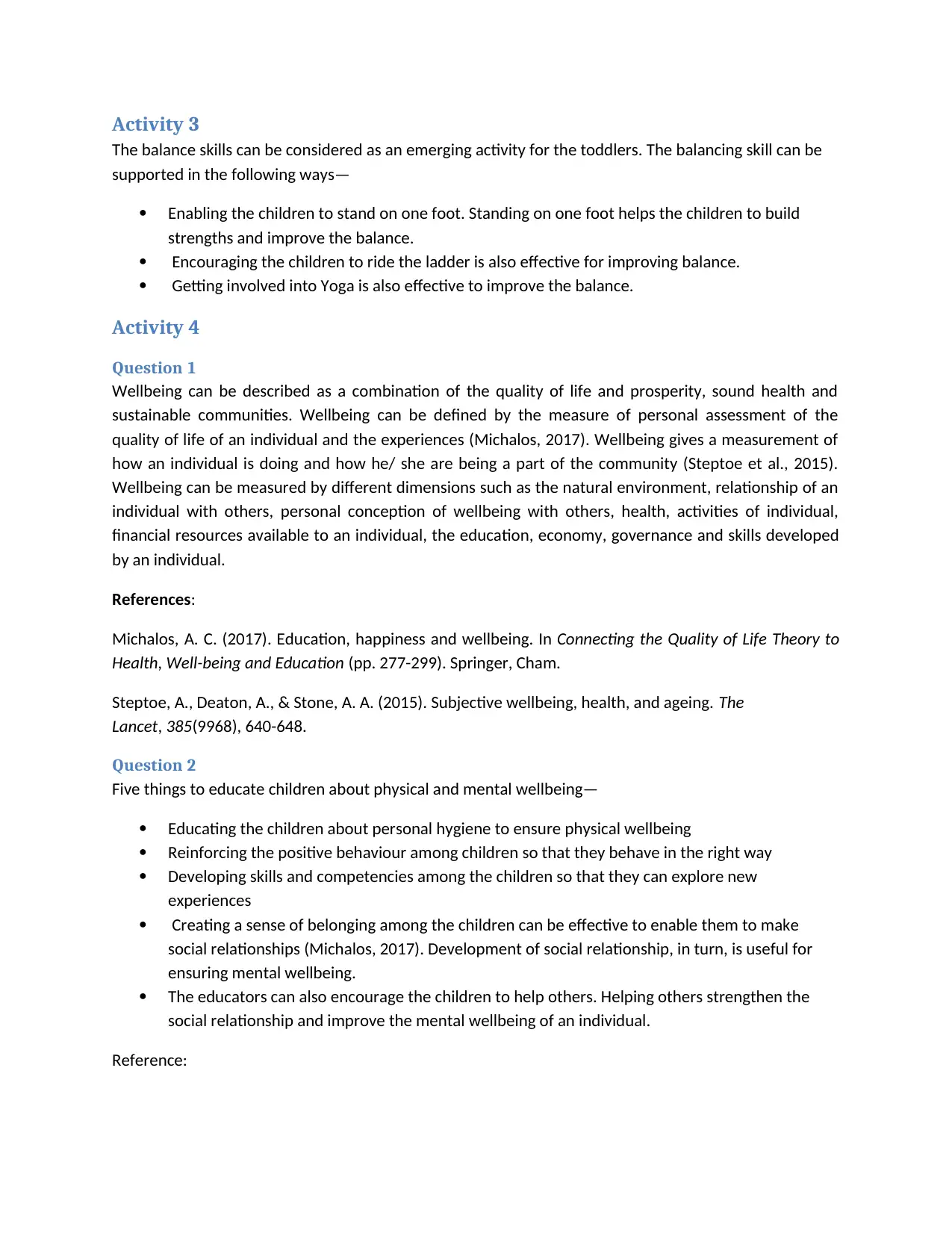
Activity 3
The balance skills can be considered as an emerging activity for the toddlers. The balancing skill can be
supported in the following ways—
Enabling the children to stand on one foot. Standing on one foot helps the children to build
strengths and improve the balance.
Encouraging the children to ride the ladder is also effective for improving balance.
Getting involved into Yoga is also effective to improve the balance.
Activity 4
Question 1
Wellbeing can be described as a combination of the quality of life and prosperity, sound health and
sustainable communities. Wellbeing can be defined by the measure of personal assessment of the
quality of life of an individual and the experiences (Michalos, 2017). Wellbeing gives a measurement of
how an individual is doing and how he/ she are being a part of the community (Steptoe et al., 2015).
Wellbeing can be measured by different dimensions such as the natural environment, relationship of an
individual with others, personal conception of wellbeing with others, health, activities of individual,
financial resources available to an individual, the education, economy, governance and skills developed
by an individual.
References:
Michalos, A. C. (2017). Education, happiness and wellbeing. In Connecting the Quality of Life Theory to
Health, Well-being and Education (pp. 277-299). Springer, Cham.
Steptoe, A., Deaton, A., & Stone, A. A. (2015). Subjective wellbeing, health, and ageing. The
Lancet, 385(9968), 640-648.
Question 2
Five things to educate children about physical and mental wellbeing—
Educating the children about personal hygiene to ensure physical wellbeing
Reinforcing the positive behaviour among children so that they behave in the right way
Developing skills and competencies among the children so that they can explore new
experiences
Creating a sense of belonging among the children can be effective to enable them to make
social relationships (Michalos, 2017). Development of social relationship, in turn, is useful for
ensuring mental wellbeing.
The educators can also encourage the children to help others. Helping others strengthen the
social relationship and improve the mental wellbeing of an individual.
Reference:
The balance skills can be considered as an emerging activity for the toddlers. The balancing skill can be
supported in the following ways—
Enabling the children to stand on one foot. Standing on one foot helps the children to build
strengths and improve the balance.
Encouraging the children to ride the ladder is also effective for improving balance.
Getting involved into Yoga is also effective to improve the balance.
Activity 4
Question 1
Wellbeing can be described as a combination of the quality of life and prosperity, sound health and
sustainable communities. Wellbeing can be defined by the measure of personal assessment of the
quality of life of an individual and the experiences (Michalos, 2017). Wellbeing gives a measurement of
how an individual is doing and how he/ she are being a part of the community (Steptoe et al., 2015).
Wellbeing can be measured by different dimensions such as the natural environment, relationship of an
individual with others, personal conception of wellbeing with others, health, activities of individual,
financial resources available to an individual, the education, economy, governance and skills developed
by an individual.
References:
Michalos, A. C. (2017). Education, happiness and wellbeing. In Connecting the Quality of Life Theory to
Health, Well-being and Education (pp. 277-299). Springer, Cham.
Steptoe, A., Deaton, A., & Stone, A. A. (2015). Subjective wellbeing, health, and ageing. The
Lancet, 385(9968), 640-648.
Question 2
Five things to educate children about physical and mental wellbeing—
Educating the children about personal hygiene to ensure physical wellbeing
Reinforcing the positive behaviour among children so that they behave in the right way
Developing skills and competencies among the children so that they can explore new
experiences
Creating a sense of belonging among the children can be effective to enable them to make
social relationships (Michalos, 2017). Development of social relationship, in turn, is useful for
ensuring mental wellbeing.
The educators can also encourage the children to help others. Helping others strengthen the
social relationship and improve the mental wellbeing of an individual.
Reference:
⊘ This is a preview!⊘
Do you want full access?
Subscribe today to unlock all pages.

Trusted by 1+ million students worldwide
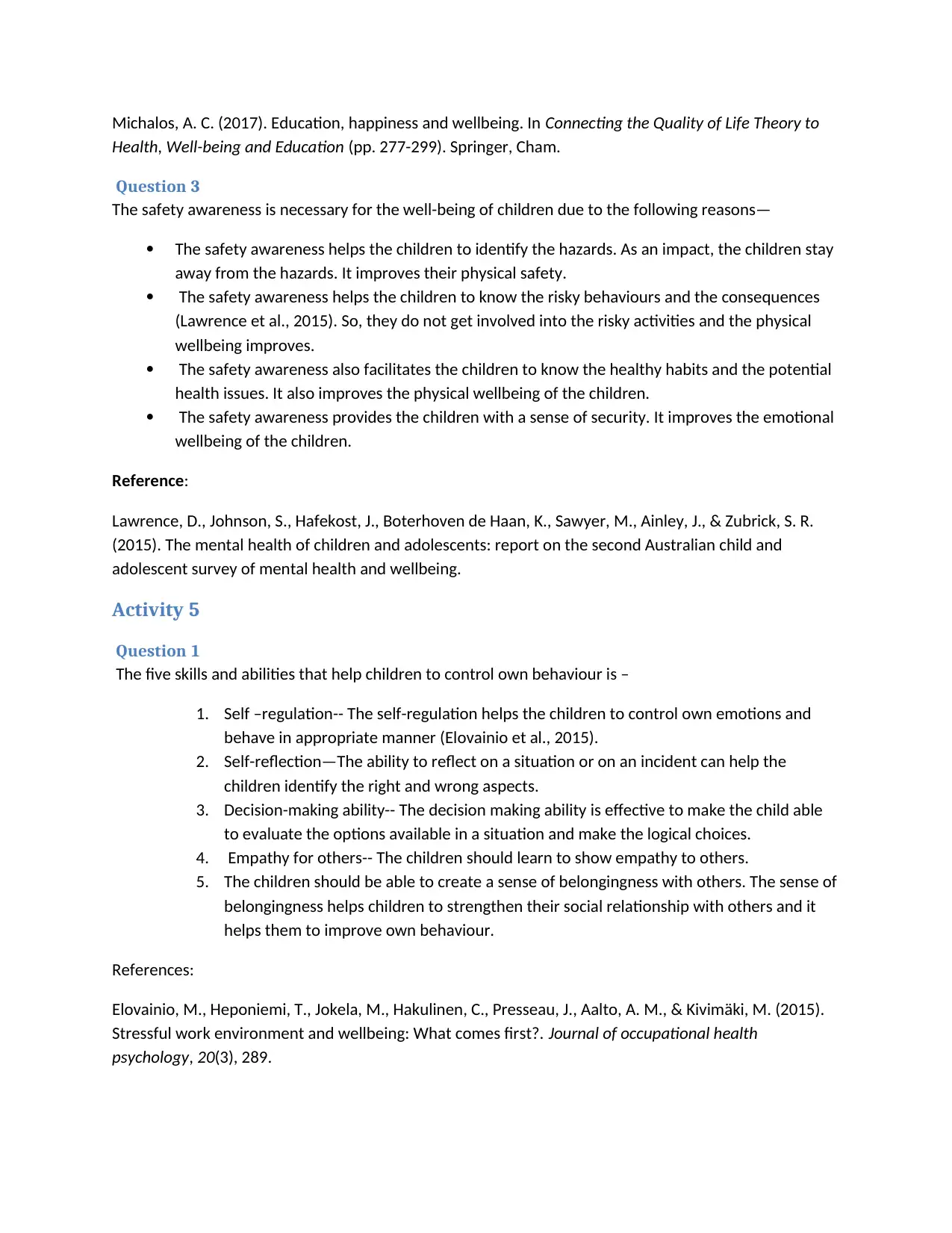
Michalos, A. C. (2017). Education, happiness and wellbeing. In Connecting the Quality of Life Theory to
Health, Well-being and Education (pp. 277-299). Springer, Cham.
Question 3
The safety awareness is necessary for the well-being of children due to the following reasons—
The safety awareness helps the children to identify the hazards. As an impact, the children stay
away from the hazards. It improves their physical safety.
The safety awareness helps the children to know the risky behaviours and the consequences
(Lawrence et al., 2015). So, they do not get involved into the risky activities and the physical
wellbeing improves.
The safety awareness also facilitates the children to know the healthy habits and the potential
health issues. It also improves the physical wellbeing of the children.
The safety awareness provides the children with a sense of security. It improves the emotional
wellbeing of the children.
Reference:
Lawrence, D., Johnson, S., Hafekost, J., Boterhoven de Haan, K., Sawyer, M., Ainley, J., & Zubrick, S. R.
(2015). The mental health of children and adolescents: report on the second Australian child and
adolescent survey of mental health and wellbeing.
Activity 5
Question 1
The five skills and abilities that help children to control own behaviour is –
1. Self –regulation-- The self-regulation helps the children to control own emotions and
behave in appropriate manner (Elovainio et al., 2015).
2. Self-reflection—The ability to reflect on a situation or on an incident can help the
children identify the right and wrong aspects.
3. Decision-making ability-- The decision making ability is effective to make the child able
to evaluate the options available in a situation and make the logical choices.
4. Empathy for others-- The children should learn to show empathy to others.
5. The children should be able to create a sense of belongingness with others. The sense of
belongingness helps children to strengthen their social relationship with others and it
helps them to improve own behaviour.
References:
Elovainio, M., Heponiemi, T., Jokela, M., Hakulinen, C., Presseau, J., Aalto, A. M., & Kivimäki, M. (2015).
Stressful work environment and wellbeing: What comes first?. Journal of occupational health
psychology, 20(3), 289.
Health, Well-being and Education (pp. 277-299). Springer, Cham.
Question 3
The safety awareness is necessary for the well-being of children due to the following reasons—
The safety awareness helps the children to identify the hazards. As an impact, the children stay
away from the hazards. It improves their physical safety.
The safety awareness helps the children to know the risky behaviours and the consequences
(Lawrence et al., 2015). So, they do not get involved into the risky activities and the physical
wellbeing improves.
The safety awareness also facilitates the children to know the healthy habits and the potential
health issues. It also improves the physical wellbeing of the children.
The safety awareness provides the children with a sense of security. It improves the emotional
wellbeing of the children.
Reference:
Lawrence, D., Johnson, S., Hafekost, J., Boterhoven de Haan, K., Sawyer, M., Ainley, J., & Zubrick, S. R.
(2015). The mental health of children and adolescents: report on the second Australian child and
adolescent survey of mental health and wellbeing.
Activity 5
Question 1
The five skills and abilities that help children to control own behaviour is –
1. Self –regulation-- The self-regulation helps the children to control own emotions and
behave in appropriate manner (Elovainio et al., 2015).
2. Self-reflection—The ability to reflect on a situation or on an incident can help the
children identify the right and wrong aspects.
3. Decision-making ability-- The decision making ability is effective to make the child able
to evaluate the options available in a situation and make the logical choices.
4. Empathy for others-- The children should learn to show empathy to others.
5. The children should be able to create a sense of belongingness with others. The sense of
belongingness helps children to strengthen their social relationship with others and it
helps them to improve own behaviour.
References:
Elovainio, M., Heponiemi, T., Jokela, M., Hakulinen, C., Presseau, J., Aalto, A. M., & Kivimäki, M. (2015).
Stressful work environment and wellbeing: What comes first?. Journal of occupational health
psychology, 20(3), 289.
Paraphrase This Document
Need a fresh take? Get an instant paraphrase of this document with our AI Paraphraser
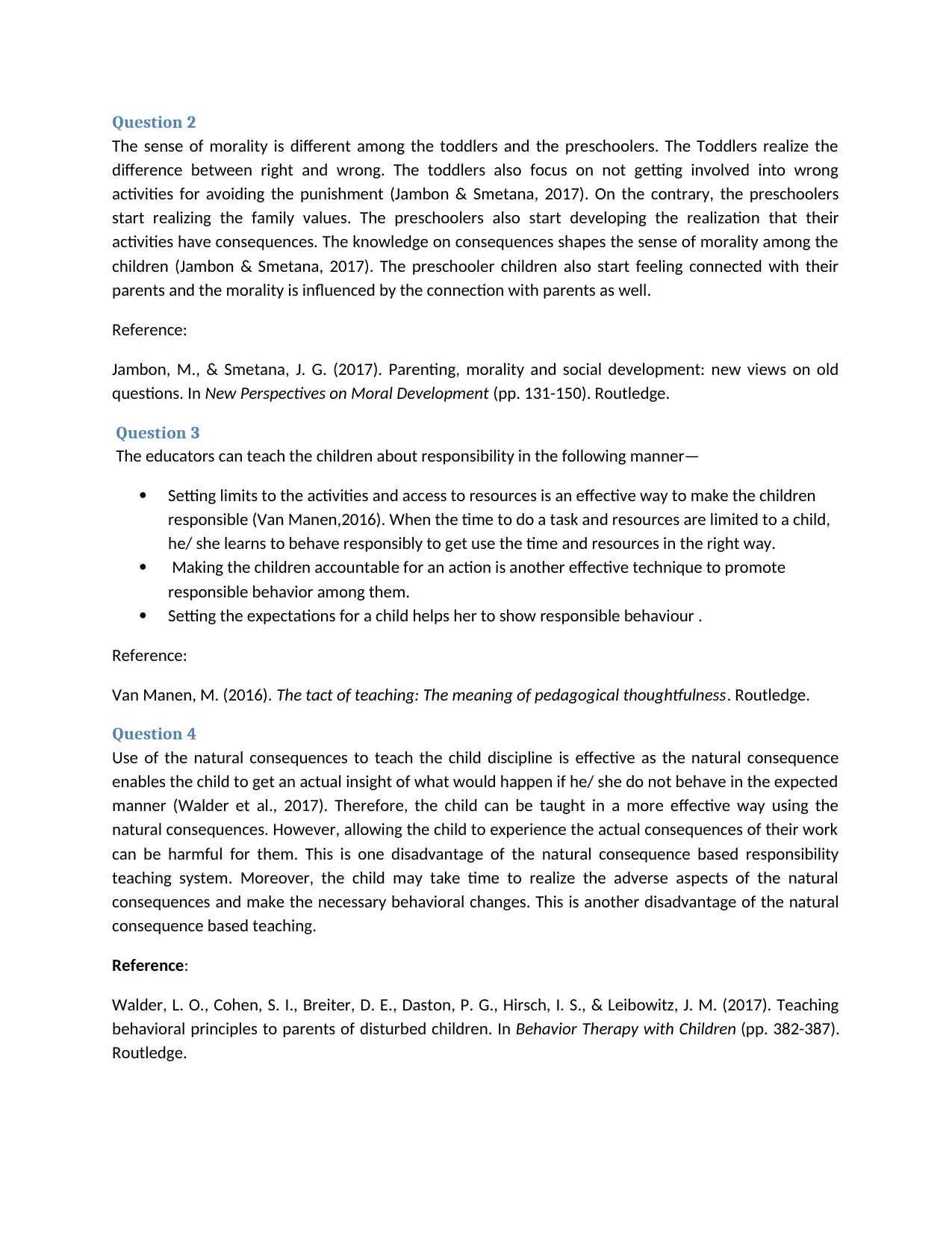
Question 2
The sense of morality is different among the toddlers and the preschoolers. The Toddlers realize the
difference between right and wrong. The toddlers also focus on not getting involved into wrong
activities for avoiding the punishment (Jambon & Smetana, 2017). On the contrary, the preschoolers
start realizing the family values. The preschoolers also start developing the realization that their
activities have consequences. The knowledge on consequences shapes the sense of morality among the
children (Jambon & Smetana, 2017). The preschooler children also start feeling connected with their
parents and the morality is influenced by the connection with parents as well.
Reference:
Jambon, M., & Smetana, J. G. (2017). Parenting, morality and social development: new views on old
questions. In New Perspectives on Moral Development (pp. 131-150). Routledge.
Question 3
The educators can teach the children about responsibility in the following manner—
Setting limits to the activities and access to resources is an effective way to make the children
responsible (Van Manen,2016). When the time to do a task and resources are limited to a child,
he/ she learns to behave responsibly to get use the time and resources in the right way.
Making the children accountable for an action is another effective technique to promote
responsible behavior among them.
Setting the expectations for a child helps her to show responsible behaviour .
Reference:
Van Manen, M. (2016). The tact of teaching: The meaning of pedagogical thoughtfulness. Routledge.
Question 4
Use of the natural consequences to teach the child discipline is effective as the natural consequence
enables the child to get an actual insight of what would happen if he/ she do not behave in the expected
manner (Walder et al., 2017). Therefore, the child can be taught in a more effective way using the
natural consequences. However, allowing the child to experience the actual consequences of their work
can be harmful for them. This is one disadvantage of the natural consequence based responsibility
teaching system. Moreover, the child may take time to realize the adverse aspects of the natural
consequences and make the necessary behavioral changes. This is another disadvantage of the natural
consequence based teaching.
Reference:
Walder, L. O., Cohen, S. I., Breiter, D. E., Daston, P. G., Hirsch, I. S., & Leibowitz, J. M. (2017). Teaching
behavioral principles to parents of disturbed children. In Behavior Therapy with Children (pp. 382-387).
Routledge.
The sense of morality is different among the toddlers and the preschoolers. The Toddlers realize the
difference between right and wrong. The toddlers also focus on not getting involved into wrong
activities for avoiding the punishment (Jambon & Smetana, 2017). On the contrary, the preschoolers
start realizing the family values. The preschoolers also start developing the realization that their
activities have consequences. The knowledge on consequences shapes the sense of morality among the
children (Jambon & Smetana, 2017). The preschooler children also start feeling connected with their
parents and the morality is influenced by the connection with parents as well.
Reference:
Jambon, M., & Smetana, J. G. (2017). Parenting, morality and social development: new views on old
questions. In New Perspectives on Moral Development (pp. 131-150). Routledge.
Question 3
The educators can teach the children about responsibility in the following manner—
Setting limits to the activities and access to resources is an effective way to make the children
responsible (Van Manen,2016). When the time to do a task and resources are limited to a child,
he/ she learns to behave responsibly to get use the time and resources in the right way.
Making the children accountable for an action is another effective technique to promote
responsible behavior among them.
Setting the expectations for a child helps her to show responsible behaviour .
Reference:
Van Manen, M. (2016). The tact of teaching: The meaning of pedagogical thoughtfulness. Routledge.
Question 4
Use of the natural consequences to teach the child discipline is effective as the natural consequence
enables the child to get an actual insight of what would happen if he/ she do not behave in the expected
manner (Walder et al., 2017). Therefore, the child can be taught in a more effective way using the
natural consequences. However, allowing the child to experience the actual consequences of their work
can be harmful for them. This is one disadvantage of the natural consequence based responsibility
teaching system. Moreover, the child may take time to realize the adverse aspects of the natural
consequences and make the necessary behavioral changes. This is another disadvantage of the natural
consequence based teaching.
Reference:
Walder, L. O., Cohen, S. I., Breiter, D. E., Daston, P. G., Hirsch, I. S., & Leibowitz, J. M. (2017). Teaching
behavioral principles to parents of disturbed children. In Behavior Therapy with Children (pp. 382-387).
Routledge.
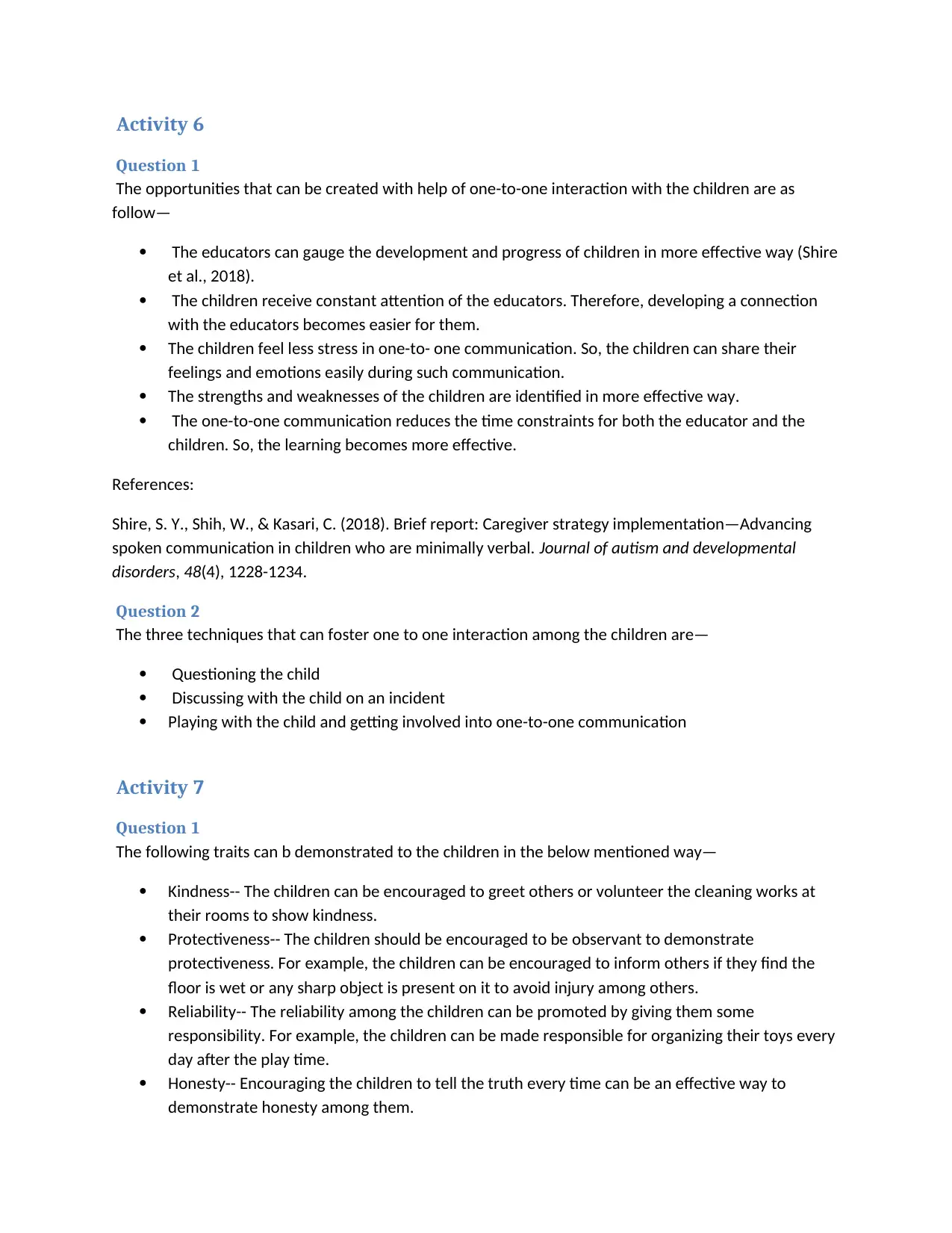
Activity 6
Question 1
The opportunities that can be created with help of one-to-one interaction with the children are as
follow—
The educators can gauge the development and progress of children in more effective way (Shire
et al., 2018).
The children receive constant attention of the educators. Therefore, developing a connection
with the educators becomes easier for them.
The children feel less stress in one-to- one communication. So, the children can share their
feelings and emotions easily during such communication.
The strengths and weaknesses of the children are identified in more effective way.
The one-to-one communication reduces the time constraints for both the educator and the
children. So, the learning becomes more effective.
References:
Shire, S. Y., Shih, W., & Kasari, C. (2018). Brief report: Caregiver strategy implementation—Advancing
spoken communication in children who are minimally verbal. Journal of autism and developmental
disorders, 48(4), 1228-1234.
Question 2
The three techniques that can foster one to one interaction among the children are—
Questioning the child
Discussing with the child on an incident
Playing with the child and getting involved into one-to-one communication
Activity 7
Question 1
The following traits can b demonstrated to the children in the below mentioned way—
Kindness-- The children can be encouraged to greet others or volunteer the cleaning works at
their rooms to show kindness.
Protectiveness-- The children should be encouraged to be observant to demonstrate
protectiveness. For example, the children can be encouraged to inform others if they find the
floor is wet or any sharp object is present on it to avoid injury among others.
Reliability-- The reliability among the children can be promoted by giving them some
responsibility. For example, the children can be made responsible for organizing their toys every
day after the play time.
Honesty-- Encouraging the children to tell the truth every time can be an effective way to
demonstrate honesty among them.
Question 1
The opportunities that can be created with help of one-to-one interaction with the children are as
follow—
The educators can gauge the development and progress of children in more effective way (Shire
et al., 2018).
The children receive constant attention of the educators. Therefore, developing a connection
with the educators becomes easier for them.
The children feel less stress in one-to- one communication. So, the children can share their
feelings and emotions easily during such communication.
The strengths and weaknesses of the children are identified in more effective way.
The one-to-one communication reduces the time constraints for both the educator and the
children. So, the learning becomes more effective.
References:
Shire, S. Y., Shih, W., & Kasari, C. (2018). Brief report: Caregiver strategy implementation—Advancing
spoken communication in children who are minimally verbal. Journal of autism and developmental
disorders, 48(4), 1228-1234.
Question 2
The three techniques that can foster one to one interaction among the children are—
Questioning the child
Discussing with the child on an incident
Playing with the child and getting involved into one-to-one communication
Activity 7
Question 1
The following traits can b demonstrated to the children in the below mentioned way—
Kindness-- The children can be encouraged to greet others or volunteer the cleaning works at
their rooms to show kindness.
Protectiveness-- The children should be encouraged to be observant to demonstrate
protectiveness. For example, the children can be encouraged to inform others if they find the
floor is wet or any sharp object is present on it to avoid injury among others.
Reliability-- The reliability among the children can be promoted by giving them some
responsibility. For example, the children can be made responsible for organizing their toys every
day after the play time.
Honesty-- Encouraging the children to tell the truth every time can be an effective way to
demonstrate honesty among them.
⊘ This is a preview!⊘
Do you want full access?
Subscribe today to unlock all pages.

Trusted by 1+ million students worldwide
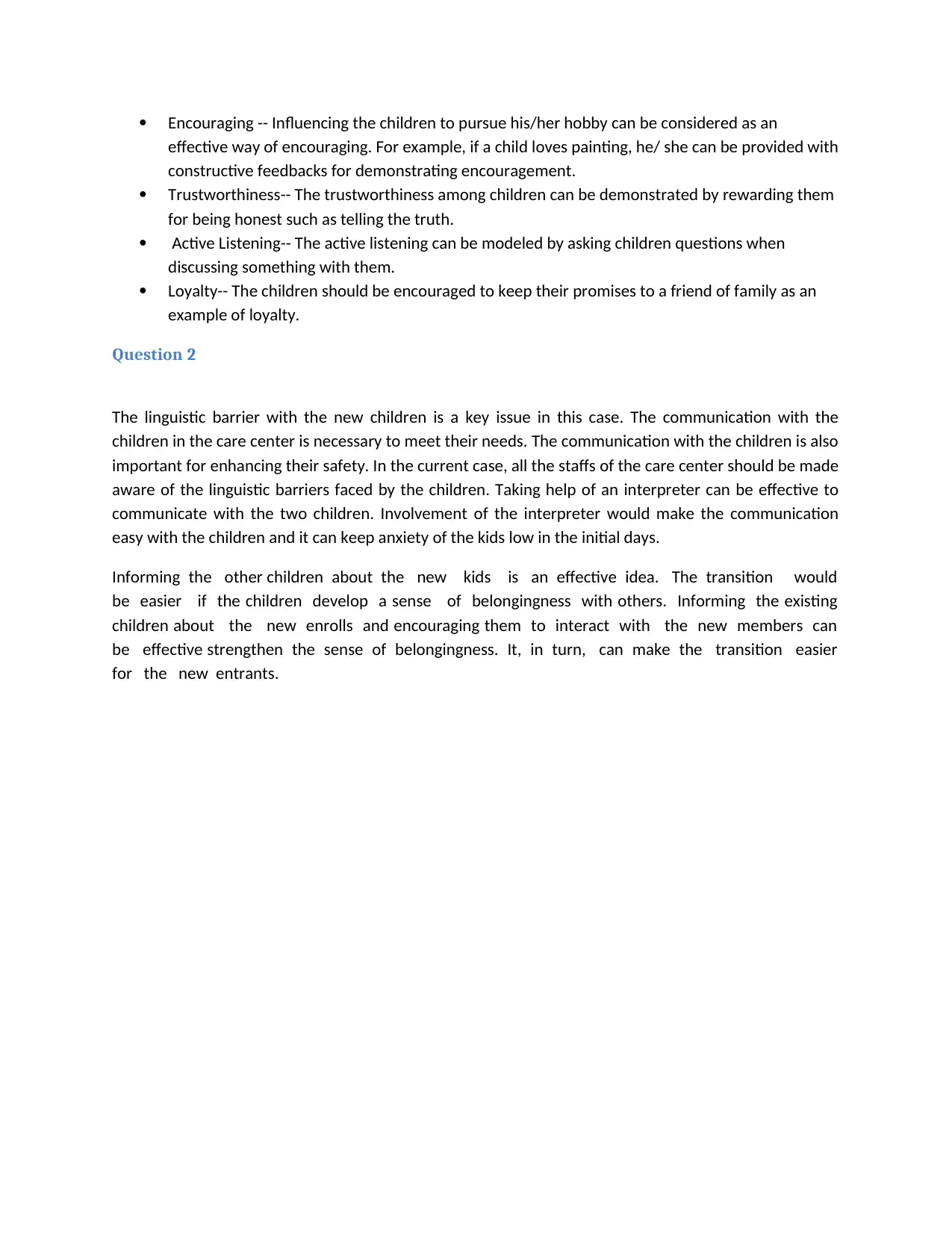
Encouraging -- Influencing the children to pursue his/her hobby can be considered as an
effective way of encouraging. For example, if a child loves painting, he/ she can be provided with
constructive feedbacks for demonstrating encouragement.
Trustworthiness-- The trustworthiness among children can be demonstrated by rewarding them
for being honest such as telling the truth.
Active Listening-- The active listening can be modeled by asking children questions when
discussing something with them.
Loyalty-- The children should be encouraged to keep their promises to a friend of family as an
example of loyalty.
Question 2
The linguistic barrier with the new children is a key issue in this case. The communication with the
children in the care center is necessary to meet their needs. The communication with the children is also
important for enhancing their safety. In the current case, all the staffs of the care center should be made
aware of the linguistic barriers faced by the children. Taking help of an interpreter can be effective to
communicate with the two children. Involvement of the interpreter would make the communication
easy with the children and it can keep anxiety of the kids low in the initial days.
Informing the other children about the new kids is an effective idea. The transition would
be easier if the children develop a sense of belongingness with others. Informing the existing
children about the new enrolls and encouraging them to interact with the new members can
be effective strengthen the sense of belongingness. It, in turn, can make the transition easier
for the new entrants.
effective way of encouraging. For example, if a child loves painting, he/ she can be provided with
constructive feedbacks for demonstrating encouragement.
Trustworthiness-- The trustworthiness among children can be demonstrated by rewarding them
for being honest such as telling the truth.
Active Listening-- The active listening can be modeled by asking children questions when
discussing something with them.
Loyalty-- The children should be encouraged to keep their promises to a friend of family as an
example of loyalty.
Question 2
The linguistic barrier with the new children is a key issue in this case. The communication with the
children in the care center is necessary to meet their needs. The communication with the children is also
important for enhancing their safety. In the current case, all the staffs of the care center should be made
aware of the linguistic barriers faced by the children. Taking help of an interpreter can be effective to
communicate with the two children. Involvement of the interpreter would make the communication
easy with the children and it can keep anxiety of the kids low in the initial days.
Informing the other children about the new kids is an effective idea. The transition would
be easier if the children develop a sense of belongingness with others. Informing the existing
children about the new enrolls and encouraging them to interact with the new members can
be effective strengthen the sense of belongingness. It, in turn, can make the transition easier
for the new entrants.
Paraphrase This Document
Need a fresh take? Get an instant paraphrase of this document with our AI Paraphraser
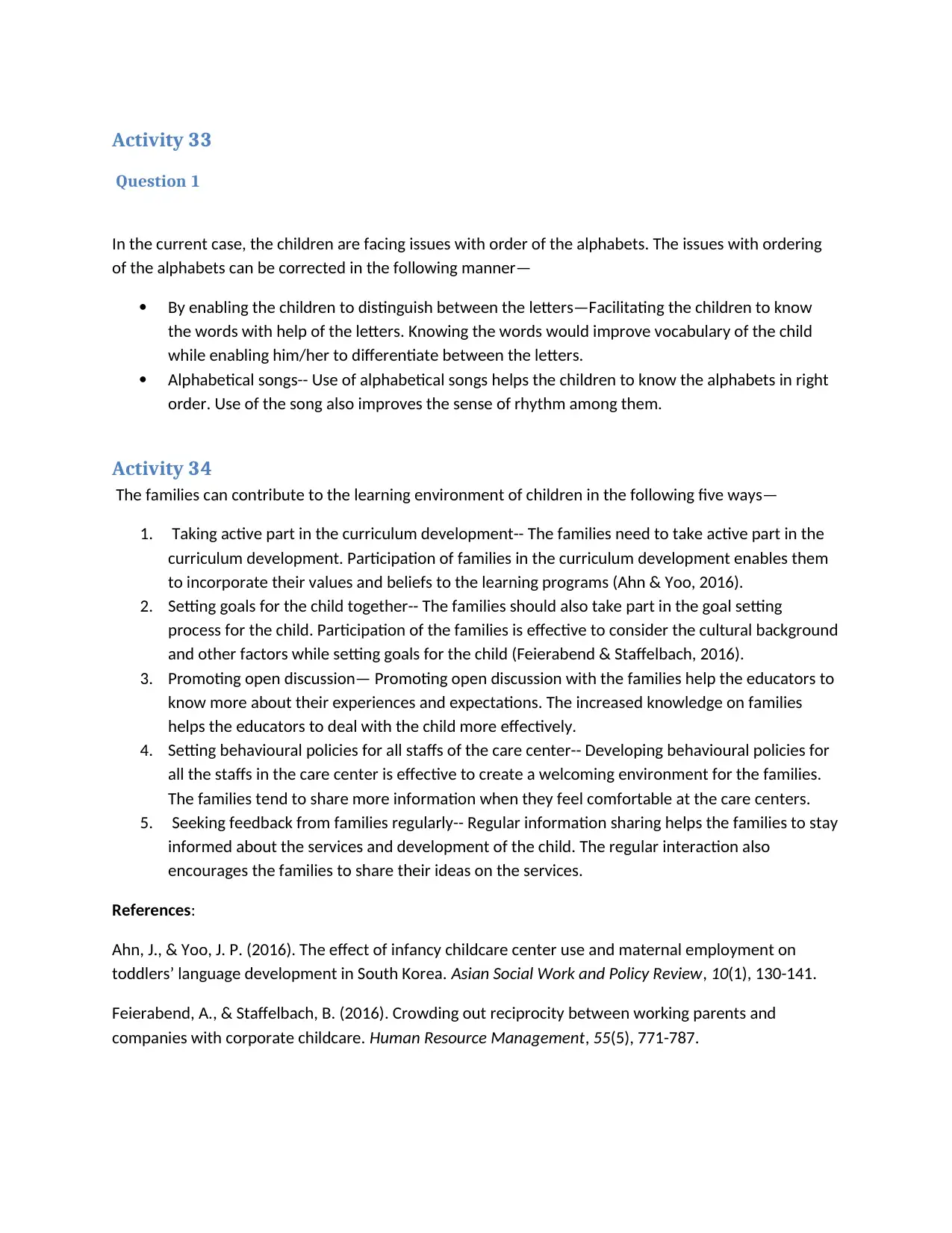
Activity 33
Question 1
In the current case, the children are facing issues with order of the alphabets. The issues with ordering
of the alphabets can be corrected in the following manner—
By enabling the children to distinguish between the letters—Facilitating the children to know
the words with help of the letters. Knowing the words would improve vocabulary of the child
while enabling him/her to differentiate between the letters.
Alphabetical songs-- Use of alphabetical songs helps the children to know the alphabets in right
order. Use of the song also improves the sense of rhythm among them.
Activity 34
The families can contribute to the learning environment of children in the following five ways—
1. Taking active part in the curriculum development-- The families need to take active part in the
curriculum development. Participation of families in the curriculum development enables them
to incorporate their values and beliefs to the learning programs (Ahn & Yoo, 2016).
2. Setting goals for the child together-- The families should also take part in the goal setting
process for the child. Participation of the families is effective to consider the cultural background
and other factors while setting goals for the child (Feierabend & Staffelbach, 2016).
3. Promoting open discussion— Promoting open discussion with the families help the educators to
know more about their experiences and expectations. The increased knowledge on families
helps the educators to deal with the child more effectively.
4. Setting behavioural policies for all staffs of the care center-- Developing behavioural policies for
all the staffs in the care center is effective to create a welcoming environment for the families.
The families tend to share more information when they feel comfortable at the care centers.
5. Seeking feedback from families regularly-- Regular information sharing helps the families to stay
informed about the services and development of the child. The regular interaction also
encourages the families to share their ideas on the services.
References:
Ahn, J., & Yoo, J. P. (2016). The effect of infancy childcare center use and maternal employment on
toddlers’ language development in South Korea. Asian Social Work and Policy Review, 10(1), 130-141.
Feierabend, A., & Staffelbach, B. (2016). Crowding out reciprocity between working parents and
companies with corporate childcare. Human Resource Management, 55(5), 771-787.
Question 1
In the current case, the children are facing issues with order of the alphabets. The issues with ordering
of the alphabets can be corrected in the following manner—
By enabling the children to distinguish between the letters—Facilitating the children to know
the words with help of the letters. Knowing the words would improve vocabulary of the child
while enabling him/her to differentiate between the letters.
Alphabetical songs-- Use of alphabetical songs helps the children to know the alphabets in right
order. Use of the song also improves the sense of rhythm among them.
Activity 34
The families can contribute to the learning environment of children in the following five ways—
1. Taking active part in the curriculum development-- The families need to take active part in the
curriculum development. Participation of families in the curriculum development enables them
to incorporate their values and beliefs to the learning programs (Ahn & Yoo, 2016).
2. Setting goals for the child together-- The families should also take part in the goal setting
process for the child. Participation of the families is effective to consider the cultural background
and other factors while setting goals for the child (Feierabend & Staffelbach, 2016).
3. Promoting open discussion— Promoting open discussion with the families help the educators to
know more about their experiences and expectations. The increased knowledge on families
helps the educators to deal with the child more effectively.
4. Setting behavioural policies for all staffs of the care center-- Developing behavioural policies for
all the staffs in the care center is effective to create a welcoming environment for the families.
The families tend to share more information when they feel comfortable at the care centers.
5. Seeking feedback from families regularly-- Regular information sharing helps the families to stay
informed about the services and development of the child. The regular interaction also
encourages the families to share their ideas on the services.
References:
Ahn, J., & Yoo, J. P. (2016). The effect of infancy childcare center use and maternal employment on
toddlers’ language development in South Korea. Asian Social Work and Policy Review, 10(1), 130-141.
Feierabend, A., & Staffelbach, B. (2016). Crowding out reciprocity between working parents and
companies with corporate childcare. Human Resource Management, 55(5), 771-787.
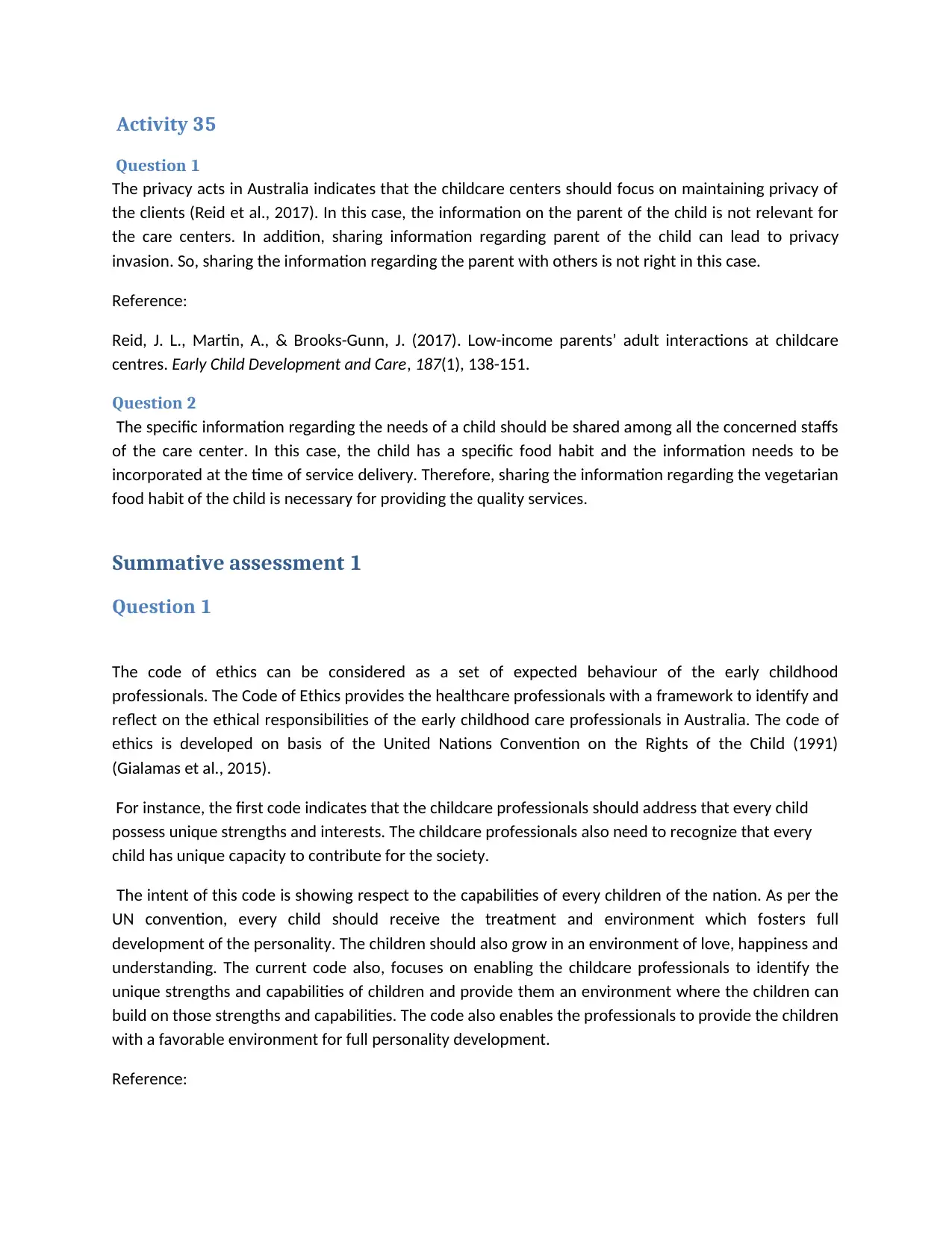
Activity 35
Question 1
The privacy acts in Australia indicates that the childcare centers should focus on maintaining privacy of
the clients (Reid et al., 2017). In this case, the information on the parent of the child is not relevant for
the care centers. In addition, sharing information regarding parent of the child can lead to privacy
invasion. So, sharing the information regarding the parent with others is not right in this case.
Reference:
Reid, J. L., Martin, A., & Brooks-Gunn, J. (2017). Low-income parents’ adult interactions at childcare
centres. Early Child Development and Care, 187(1), 138-151.
Question 2
The specific information regarding the needs of a child should be shared among all the concerned staffs
of the care center. In this case, the child has a specific food habit and the information needs to be
incorporated at the time of service delivery. Therefore, sharing the information regarding the vegetarian
food habit of the child is necessary for providing the quality services.
Summative assessment 1
Question 1
The code of ethics can be considered as a set of expected behaviour of the early childhood
professionals. The Code of Ethics provides the healthcare professionals with a framework to identify and
reflect on the ethical responsibilities of the early childhood care professionals in Australia. The code of
ethics is developed on basis of the United Nations Convention on the Rights of the Child (1991)
(Gialamas et al., 2015).
For instance, the first code indicates that the childcare professionals should address that every child
possess unique strengths and interests. The childcare professionals also need to recognize that every
child has unique capacity to contribute for the society.
The intent of this code is showing respect to the capabilities of every children of the nation. As per the
UN convention, every child should receive the treatment and environment which fosters full
development of the personality. The children should also grow in an environment of love, happiness and
understanding. The current code also, focuses on enabling the childcare professionals to identify the
unique strengths and capabilities of children and provide them an environment where the children can
build on those strengths and capabilities. The code also enables the professionals to provide the children
with a favorable environment for full personality development.
Reference:
Question 1
The privacy acts in Australia indicates that the childcare centers should focus on maintaining privacy of
the clients (Reid et al., 2017). In this case, the information on the parent of the child is not relevant for
the care centers. In addition, sharing information regarding parent of the child can lead to privacy
invasion. So, sharing the information regarding the parent with others is not right in this case.
Reference:
Reid, J. L., Martin, A., & Brooks-Gunn, J. (2017). Low-income parents’ adult interactions at childcare
centres. Early Child Development and Care, 187(1), 138-151.
Question 2
The specific information regarding the needs of a child should be shared among all the concerned staffs
of the care center. In this case, the child has a specific food habit and the information needs to be
incorporated at the time of service delivery. Therefore, sharing the information regarding the vegetarian
food habit of the child is necessary for providing the quality services.
Summative assessment 1
Question 1
The code of ethics can be considered as a set of expected behaviour of the early childhood
professionals. The Code of Ethics provides the healthcare professionals with a framework to identify and
reflect on the ethical responsibilities of the early childhood care professionals in Australia. The code of
ethics is developed on basis of the United Nations Convention on the Rights of the Child (1991)
(Gialamas et al., 2015).
For instance, the first code indicates that the childcare professionals should address that every child
possess unique strengths and interests. The childcare professionals also need to recognize that every
child has unique capacity to contribute for the society.
The intent of this code is showing respect to the capabilities of every children of the nation. As per the
UN convention, every child should receive the treatment and environment which fosters full
development of the personality. The children should also grow in an environment of love, happiness and
understanding. The current code also, focuses on enabling the childcare professionals to identify the
unique strengths and capabilities of children and provide them an environment where the children can
build on those strengths and capabilities. The code also enables the professionals to provide the children
with a favorable environment for full personality development.
Reference:
⊘ This is a preview!⊘
Do you want full access?
Subscribe today to unlock all pages.

Trusted by 1+ million students worldwide
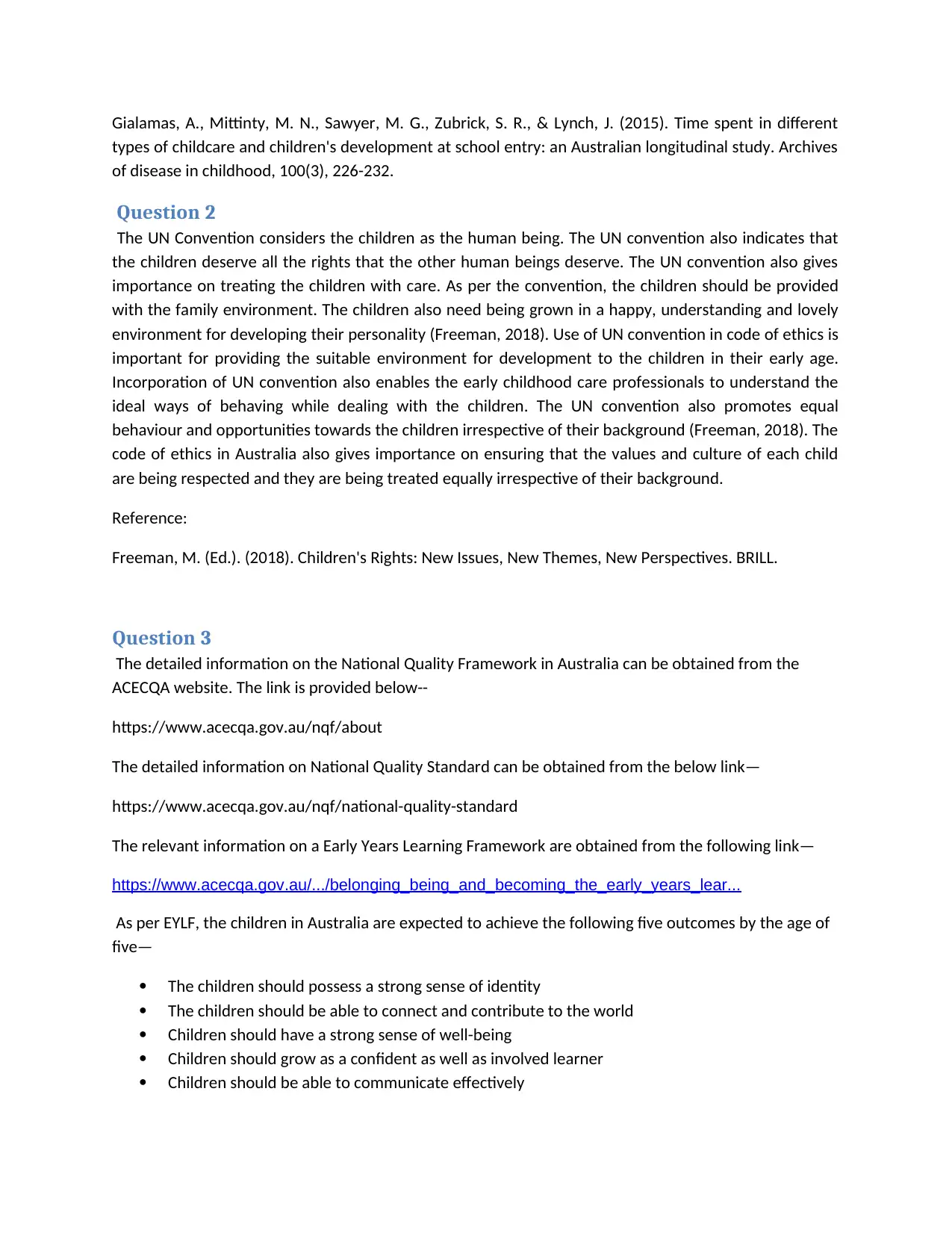
Gialamas, A., Mittinty, M. N., Sawyer, M. G., Zubrick, S. R., & Lynch, J. (2015). Time spent in different
types of childcare and children's development at school entry: an Australian longitudinal study. Archives
of disease in childhood, 100(3), 226-232.
Question 2
The UN Convention considers the children as the human being. The UN convention also indicates that
the children deserve all the rights that the other human beings deserve. The UN convention also gives
importance on treating the children with care. As per the convention, the children should be provided
with the family environment. The children also need being grown in a happy, understanding and lovely
environment for developing their personality (Freeman, 2018). Use of UN convention in code of ethics is
important for providing the suitable environment for development to the children in their early age.
Incorporation of UN convention also enables the early childhood care professionals to understand the
ideal ways of behaving while dealing with the children. The UN convention also promotes equal
behaviour and opportunities towards the children irrespective of their background (Freeman, 2018). The
code of ethics in Australia also gives importance on ensuring that the values and culture of each child
are being respected and they are being treated equally irrespective of their background.
Reference:
Freeman, M. (Ed.). (2018). Children's Rights: New Issues, New Themes, New Perspectives. BRILL.
Question 3
The detailed information on the National Quality Framework in Australia can be obtained from the
ACECQA website. The link is provided below--
https://www.acecqa.gov.au/nqf/about
The detailed information on National Quality Standard can be obtained from the below link—
https://www.acecqa.gov.au/nqf/national-quality-standard
The relevant information on a Early Years Learning Framework are obtained from the following link—
https://www.acecqa.gov.au/.../belonging_being_and_becoming_the_early_years_lear...
As per EYLF, the children in Australia are expected to achieve the following five outcomes by the age of
five—
The children should possess a strong sense of identity
The children should be able to connect and contribute to the world
Children should have a strong sense of well-being
Children should grow as a confident as well as involved learner
Children should be able to communicate effectively
types of childcare and children's development at school entry: an Australian longitudinal study. Archives
of disease in childhood, 100(3), 226-232.
Question 2
The UN Convention considers the children as the human being. The UN convention also indicates that
the children deserve all the rights that the other human beings deserve. The UN convention also gives
importance on treating the children with care. As per the convention, the children should be provided
with the family environment. The children also need being grown in a happy, understanding and lovely
environment for developing their personality (Freeman, 2018). Use of UN convention in code of ethics is
important for providing the suitable environment for development to the children in their early age.
Incorporation of UN convention also enables the early childhood care professionals to understand the
ideal ways of behaving while dealing with the children. The UN convention also promotes equal
behaviour and opportunities towards the children irrespective of their background (Freeman, 2018). The
code of ethics in Australia also gives importance on ensuring that the values and culture of each child
are being respected and they are being treated equally irrespective of their background.
Reference:
Freeman, M. (Ed.). (2018). Children's Rights: New Issues, New Themes, New Perspectives. BRILL.
Question 3
The detailed information on the National Quality Framework in Australia can be obtained from the
ACECQA website. The link is provided below--
https://www.acecqa.gov.au/nqf/about
The detailed information on National Quality Standard can be obtained from the below link—
https://www.acecqa.gov.au/nqf/national-quality-standard
The relevant information on a Early Years Learning Framework are obtained from the following link—
https://www.acecqa.gov.au/.../belonging_being_and_becoming_the_early_years_lear...
As per EYLF, the children in Australia are expected to achieve the following five outcomes by the age of
five—
The children should possess a strong sense of identity
The children should be able to connect and contribute to the world
Children should have a strong sense of well-being
Children should grow as a confident as well as involved learner
Children should be able to communicate effectively
Paraphrase This Document
Need a fresh take? Get an instant paraphrase of this document with our AI Paraphraser
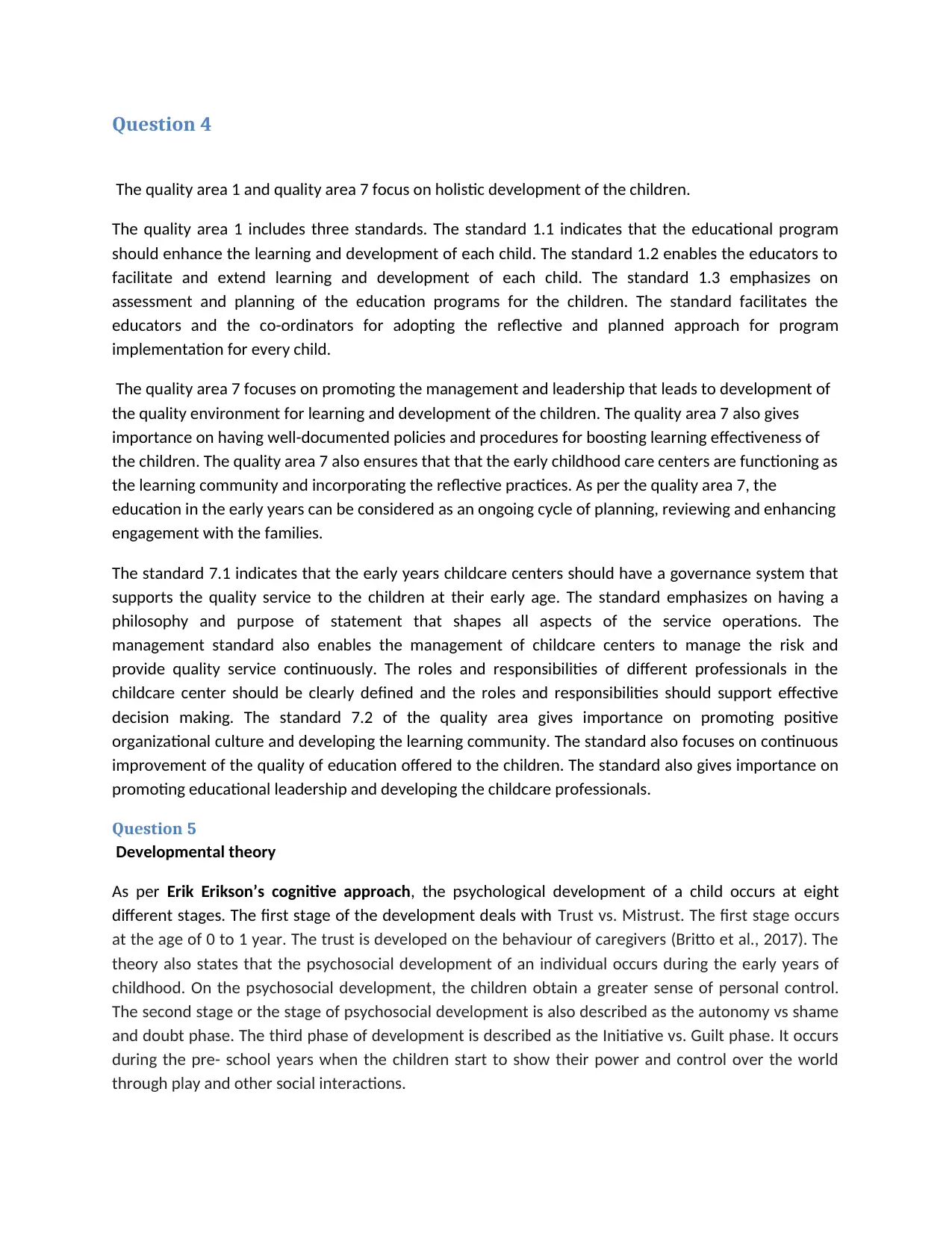
Question 4
The quality area 1 and quality area 7 focus on holistic development of the children.
The quality area 1 includes three standards. The standard 1.1 indicates that the educational program
should enhance the learning and development of each child. The standard 1.2 enables the educators to
facilitate and extend learning and development of each child. The standard 1.3 emphasizes on
assessment and planning of the education programs for the children. The standard facilitates the
educators and the co-ordinators for adopting the reflective and planned approach for program
implementation for every child.
The quality area 7 focuses on promoting the management and leadership that leads to development of
the quality environment for learning and development of the children. The quality area 7 also gives
importance on having well-documented policies and procedures for boosting learning effectiveness of
the children. The quality area 7 also ensures that that the early childhood care centers are functioning as
the learning community and incorporating the reflective practices. As per the quality area 7, the
education in the early years can be considered as an ongoing cycle of planning, reviewing and enhancing
engagement with the families.
The standard 7.1 indicates that the early years childcare centers should have a governance system that
supports the quality service to the children at their early age. The standard emphasizes on having a
philosophy and purpose of statement that shapes all aspects of the service operations. The
management standard also enables the management of childcare centers to manage the risk and
provide quality service continuously. The roles and responsibilities of different professionals in the
childcare center should be clearly defined and the roles and responsibilities should support effective
decision making. The standard 7.2 of the quality area gives importance on promoting positive
organizational culture and developing the learning community. The standard also focuses on continuous
improvement of the quality of education offered to the children. The standard also gives importance on
promoting educational leadership and developing the childcare professionals.
Question 5
Developmental theory
As per Erik Erikson’s cognitive approach, the psychological development of a child occurs at eight
different stages. The first stage of the development deals with Trust vs. Mistrust. The first stage occurs
at the age of 0 to 1 year. The trust is developed on the behaviour of caregivers (Britto et al., 2017). The
theory also states that the psychosocial development of an individual occurs during the early years of
childhood. On the psychosocial development, the children obtain a greater sense of personal control.
The second stage or the stage of psychosocial development is also described as the autonomy vs shame
and doubt phase. The third phase of development is described as the Initiative vs. Guilt phase. It occurs
during the pre- school years when the children start to show their power and control over the world
through play and other social interactions.
The quality area 1 and quality area 7 focus on holistic development of the children.
The quality area 1 includes three standards. The standard 1.1 indicates that the educational program
should enhance the learning and development of each child. The standard 1.2 enables the educators to
facilitate and extend learning and development of each child. The standard 1.3 emphasizes on
assessment and planning of the education programs for the children. The standard facilitates the
educators and the co-ordinators for adopting the reflective and planned approach for program
implementation for every child.
The quality area 7 focuses on promoting the management and leadership that leads to development of
the quality environment for learning and development of the children. The quality area 7 also gives
importance on having well-documented policies and procedures for boosting learning effectiveness of
the children. The quality area 7 also ensures that that the early childhood care centers are functioning as
the learning community and incorporating the reflective practices. As per the quality area 7, the
education in the early years can be considered as an ongoing cycle of planning, reviewing and enhancing
engagement with the families.
The standard 7.1 indicates that the early years childcare centers should have a governance system that
supports the quality service to the children at their early age. The standard emphasizes on having a
philosophy and purpose of statement that shapes all aspects of the service operations. The
management standard also enables the management of childcare centers to manage the risk and
provide quality service continuously. The roles and responsibilities of different professionals in the
childcare center should be clearly defined and the roles and responsibilities should support effective
decision making. The standard 7.2 of the quality area gives importance on promoting positive
organizational culture and developing the learning community. The standard also focuses on continuous
improvement of the quality of education offered to the children. The standard also gives importance on
promoting educational leadership and developing the childcare professionals.
Question 5
Developmental theory
As per Erik Erikson’s cognitive approach, the psychological development of a child occurs at eight
different stages. The first stage of the development deals with Trust vs. Mistrust. The first stage occurs
at the age of 0 to 1 year. The trust is developed on the behaviour of caregivers (Britto et al., 2017). The
theory also states that the psychosocial development of an individual occurs during the early years of
childhood. On the psychosocial development, the children obtain a greater sense of personal control.
The second stage or the stage of psychosocial development is also described as the autonomy vs shame
and doubt phase. The third phase of development is described as the Initiative vs. Guilt phase. It occurs
during the pre- school years when the children start to show their power and control over the world
through play and other social interactions.
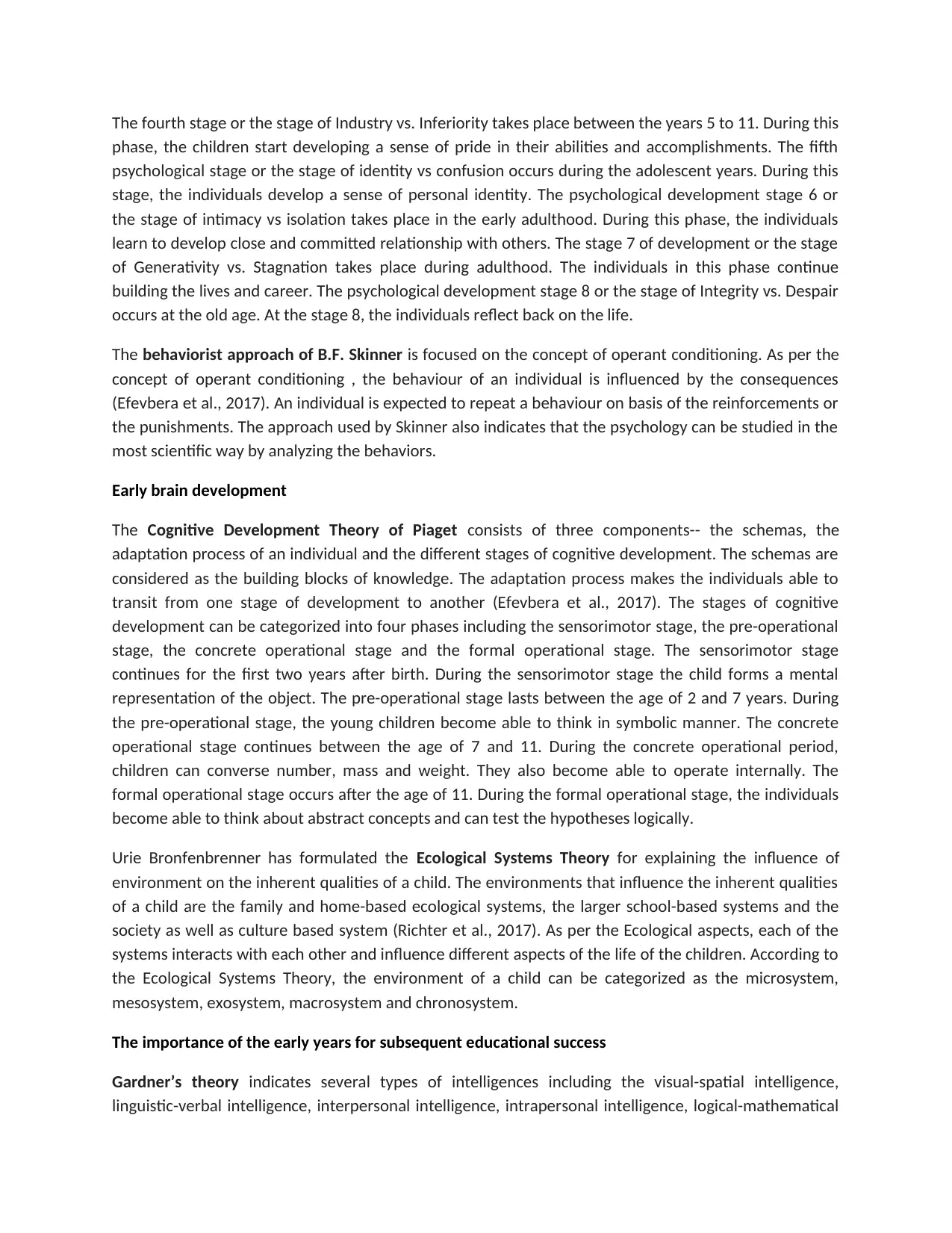
The fourth stage or the stage of Industry vs. Inferiority takes place between the years 5 to 11. During this
phase, the children start developing a sense of pride in their abilities and accomplishments. The fifth
psychological stage or the stage of identity vs confusion occurs during the adolescent years. During this
stage, the individuals develop a sense of personal identity. The psychological development stage 6 or
the stage of intimacy vs isolation takes place in the early adulthood. During this phase, the individuals
learn to develop close and committed relationship with others. The stage 7 of development or the stage
of Generativity vs. Stagnation takes place during adulthood. The individuals in this phase continue
building the lives and career. The psychological development stage 8 or the stage of Integrity vs. Despair
occurs at the old age. At the stage 8, the individuals reflect back on the life.
The behaviorist approach of B.F. Skinner is focused on the concept of operant conditioning. As per the
concept of operant conditioning , the behaviour of an individual is influenced by the consequences
(Efevbera et al., 2017). An individual is expected to repeat a behaviour on basis of the reinforcements or
the punishments. The approach used by Skinner also indicates that the psychology can be studied in the
most scientific way by analyzing the behaviors.
Early brain development
The Cognitive Development Theory of Piaget consists of three components-- the schemas, the
adaptation process of an individual and the different stages of cognitive development. The schemas are
considered as the building blocks of knowledge. The adaptation process makes the individuals able to
transit from one stage of development to another (Efevbera et al., 2017). The stages of cognitive
development can be categorized into four phases including the sensorimotor stage, the pre-operational
stage, the concrete operational stage and the formal operational stage. The sensorimotor stage
continues for the first two years after birth. During the sensorimotor stage the child forms a mental
representation of the object. The pre-operational stage lasts between the age of 2 and 7 years. During
the pre-operational stage, the young children become able to think in symbolic manner. The concrete
operational stage continues between the age of 7 and 11. During the concrete operational period,
children can converse number, mass and weight. They also become able to operate internally. The
formal operational stage occurs after the age of 11. During the formal operational stage, the individuals
become able to think about abstract concepts and can test the hypotheses logically.
Urie Bronfenbrenner has formulated the Ecological Systems Theory for explaining the influence of
environment on the inherent qualities of a child. The environments that influence the inherent qualities
of a child are the family and home-based ecological systems, the larger school-based systems and the
society as well as culture based system (Richter et al., 2017). As per the Ecological aspects, each of the
systems interacts with each other and influence different aspects of the life of the children. According to
the Ecological Systems Theory, the environment of a child can be categorized as the microsystem,
mesosystem, exosystem, macrosystem and chronosystem.
The importance of the early years for subsequent educational success
Gardner’s theory indicates several types of intelligences including the visual-spatial intelligence,
linguistic-verbal intelligence, interpersonal intelligence, intrapersonal intelligence, logical-mathematical
phase, the children start developing a sense of pride in their abilities and accomplishments. The fifth
psychological stage or the stage of identity vs confusion occurs during the adolescent years. During this
stage, the individuals develop a sense of personal identity. The psychological development stage 6 or
the stage of intimacy vs isolation takes place in the early adulthood. During this phase, the individuals
learn to develop close and committed relationship with others. The stage 7 of development or the stage
of Generativity vs. Stagnation takes place during adulthood. The individuals in this phase continue
building the lives and career. The psychological development stage 8 or the stage of Integrity vs. Despair
occurs at the old age. At the stage 8, the individuals reflect back on the life.
The behaviorist approach of B.F. Skinner is focused on the concept of operant conditioning. As per the
concept of operant conditioning , the behaviour of an individual is influenced by the consequences
(Efevbera et al., 2017). An individual is expected to repeat a behaviour on basis of the reinforcements or
the punishments. The approach used by Skinner also indicates that the psychology can be studied in the
most scientific way by analyzing the behaviors.
Early brain development
The Cognitive Development Theory of Piaget consists of three components-- the schemas, the
adaptation process of an individual and the different stages of cognitive development. The schemas are
considered as the building blocks of knowledge. The adaptation process makes the individuals able to
transit from one stage of development to another (Efevbera et al., 2017). The stages of cognitive
development can be categorized into four phases including the sensorimotor stage, the pre-operational
stage, the concrete operational stage and the formal operational stage. The sensorimotor stage
continues for the first two years after birth. During the sensorimotor stage the child forms a mental
representation of the object. The pre-operational stage lasts between the age of 2 and 7 years. During
the pre-operational stage, the young children become able to think in symbolic manner. The concrete
operational stage continues between the age of 7 and 11. During the concrete operational period,
children can converse number, mass and weight. They also become able to operate internally. The
formal operational stage occurs after the age of 11. During the formal operational stage, the individuals
become able to think about abstract concepts and can test the hypotheses logically.
Urie Bronfenbrenner has formulated the Ecological Systems Theory for explaining the influence of
environment on the inherent qualities of a child. The environments that influence the inherent qualities
of a child are the family and home-based ecological systems, the larger school-based systems and the
society as well as culture based system (Richter et al., 2017). As per the Ecological aspects, each of the
systems interacts with each other and influence different aspects of the life of the children. According to
the Ecological Systems Theory, the environment of a child can be categorized as the microsystem,
mesosystem, exosystem, macrosystem and chronosystem.
The importance of the early years for subsequent educational success
Gardner’s theory indicates several types of intelligences including the visual-spatial intelligence,
linguistic-verbal intelligence, interpersonal intelligence, intrapersonal intelligence, logical-mathematical
⊘ This is a preview!⊘
Do you want full access?
Subscribe today to unlock all pages.

Trusted by 1+ million students worldwide
1 out of 17
Related Documents
Your All-in-One AI-Powered Toolkit for Academic Success.
+13062052269
info@desklib.com
Available 24*7 on WhatsApp / Email
![[object Object]](/_next/static/media/star-bottom.7253800d.svg)
Unlock your academic potential
Copyright © 2020–2025 A2Z Services. All Rights Reserved. Developed and managed by ZUCOL.





